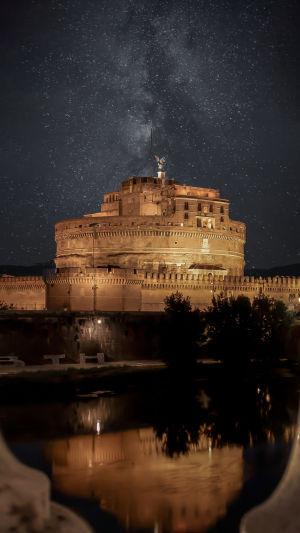Nestled within the historic embrace of Rome, Italy, stands a majestic and enigmatic fortress — Castel Sant'Angelo.
This castle bears witness to the extensive and storied history of Rome.
Today, it shines as a radiant gem in the tapestry of Rome, captivating countless tourists and history aficionados with its allure and mysteries.
<h3>Historical Background</h3>
The roots of Castel Sant'Angelo stretch back to the heart of the Roman Empire. Initially commissioned by Emperor Hadrian in 123 AD, it served as his grand mausoleum.
Across subsequent centuries, the fortress underwent numerous renovations and expansions, transitioning roles from a stronghold to a royal residence and even a carceral facility.
During the medieval era, it provided sanctuary for popes and clandestine passages connecting to the Holy See, intricately linked with the Vatican. In modern times, its distinctive historical narrative and resplendent architectural style have elevated it to a prominent landmark within the cityscape of Rome.
<h3>Architectural Marvel</h3>
Castel Sant'Angelo seamlessly blends various architectural influences, encompassing elements from ancient Rome, Gothic, and Renaissance periods, crafting a unique and captivating aesthetic.
The castle's exterior exudes grandeur, with its soaring cylindrical towers and formidable ramparts evoking a sense of solemnity and majesty. Internally, intricate adornments and masterful carvings showcase the finesse of ancient craftsmanship and the ingenuity of artistic expression.
Ascending to the castle's zenith, visitors are treated to panoramic vistas, beholding the breathtaking expanse of Rome's timeless panorama, suffused with the echoes of its storied past.
<h3>Legends and Lore</h3>
The annals of Castel Sant'Angelo are interwoven with captivating legends, further enriching its mystique and allure. According to lore, in the year 590 AD, amidst a devastating plague that gripped Rome, Pope Gregory 1 purportedly beheld a vision of an angel atop the castle, brandishing a sword in divine proclamation.
Moved by this celestial apparition, the pope led the faithful in fervent supplication, beseeching divine intervention. Miraculously, the plague abated, prompting the populace to christen the fortress "Castel Sant'Angelo," commemorating the auspicious intervention of the divine.
<h3>Present-day Splendor</h3>
In contemporary times, Castel Sant'Angelo has evolved into a premier tourist destination within Rome. Drawing millions of visitors annually, it offers an immersive journey through the annals of history.
Guests can peruse the castle's inner chambers, marveling at ancient artifacts and cultural treasures, each whispering tales of bygone eras.
Furthermore, traversing its labyrinthine passageways and strolling along its formidable battlements afford a tangible connection to the city's illustrious past. As dusk descends, the castle's illuminated facade casts an ethereal glow, heightening its allure and mystique under the cloak of night.
<h3>Conclusion: A Timeless Legacy</h3>
Castel Sant'Angelo stands as an enduring testament to Rome's indomitable spirit and enduring legacy. Its resplendent architecture, rich historical tapestry, and enduring legends beckon travelers from across the globe.
Stepping within its hallowed halls is akin to embarking on a transcendent voyage through the annals of time, communing with the august figures of ancient Rome.
May Castel Sant'Angelo continue to stand sentinel, bearing witness to the vicissitudes of Rome's fortunes, and perpetuating the timeless allure of the Eternal City for generations to come.





